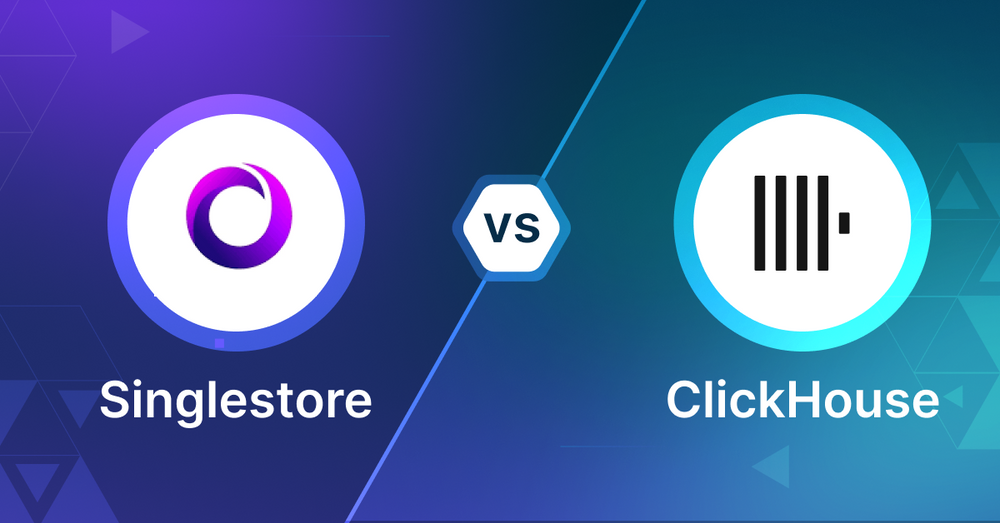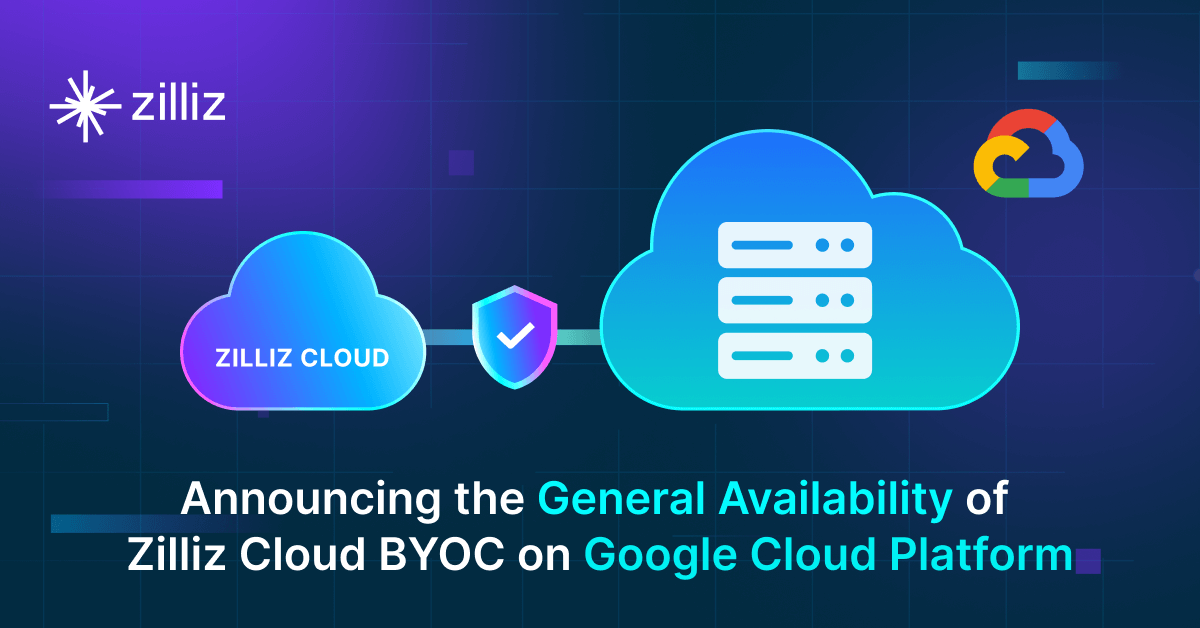SingleStore vs ClickHouse Choosing the Right Vector Database for Your AI Apps

What is a Vector Database?
Before we compare SingleStore and ClickHouse, let's first explore the concept of vector databases.
A vector database is specifically designed to store and query high-dimensional vectors, which are numerical representations of unstructured data. These vectors encode complex information, such as the semantic meaning of text, the visual features of images, or product attributes. By enabling efficient similarity searches, vector databases play a pivotal role in AI applications, allowing for more advanced data analysis and retrieval.
Common use cases for vector databases include e-commerce product recommendations, content discovery platforms, anomaly detection in cybersecurity, medical image analysis, and natural language processing (NLP) tasks. They also play a crucial role in Retrieval Augmented Generation (RAG), a technique that enhances the performance of large language models (LLMs) by providing external knowledge to reduce issues like AI hallucinations.
There are many types of vector databases available in the market, including:
- Purpose-built vector databases such as Milvus, Zilliz Cloud (fully managed Milvus)
- Vector search libraries such as Faiss and Annoy.
- Lightweight vector databases such as Chroma and Milvus Lite.
- Traditional databases with vector search add-ons capable of performing small-scale vector searches.
SingleStore is a distributed, relational, SQL database management system and ClickHouse is an open-source column-oriented database. Both with vector search as an add-on. This post compares their vector search capabilities.
SingleStore: Overview and Core Technology
SingleStore has made vector search possible by putting it in the database itself, so you don’t need separate vector databases in your tech stack. Vectors can be stored in regular database tables and searched with standard SQL queries. For example, you can search similar product images while filtering by price range or explore document embeddings while limiting results to specific departments. The system supports both semantic search using FLAT, IVF_FLAT, IVF_PQ, IVF_PQFS, HNSW_FLAT, and HNSW_PQ for vector index and dot product and Euclidean distance for similarity matching. This is super useful for applications like recommendation systems, image recognition and AI chatbots where similarity matching is fast.
At its core SingleStore is built for performance and scale. The database distributes the data across multiple nodes so you can handle large scale vector data operations. As your data grows you can just add more nodes and you’re good to go. The query processor can combine vector search with SQL operations so you don’t need to make multiple separate queries. Unlike vector only databases SingleStore gives you these capabilities as part of a full database so you can build AI features without managing multiple systems or dealing with complex data transfers.
For vector indexing SingleStore has two options. The first is exact k-nearest neighbors (kNN) search which finds the exact set of k nearest neighbors for a query vector. But for very large datasets or high concurrency SingleStore also supports Approximate Nearest Neighbor (ANN) search using vector indexing. ANN search can find k near neighbors much faster than exact kNN search sometimes by orders of magnitude. There’s a trade off between speed and accuracy - ANN is faster but may not return the exact set of k nearest neighbors. For applications with billions of vectors that need interactive response times and don’t need absolute precision ANN search is the way to go.
The technical implementation of vector indices in SingleStore has specific requirements. These indices can only be created on columnstore tables and must be created on a single column that stores the vector data. The system currently supports Vector Type(dimensions[, F32]) format, F32 is the only supported element type. This structured approach makes SingleStore great for applications like semantic search using vectors from large language models, retrieval-augmented generation (RAG) for focused text generation and image matching based on vector embeddings. By combining these with traditional database features SingleStore allows developers to build complex AI applications using SQL syntax while maintaining performance and scale.
ClickHouse: Overview and Core Technology
ClickHouse is an open-source real-time OLAP database known for its full SQL support and high-speed query processing. It excels at handling analytical queries due to its fully parallelized query pipeline, allowing it to perform vector search operations quickly. Its high levels of compression, customizable through codecs, enable ClickHouse to store and query large datasets effectively. One of its key strengths is that it can handle multi-TB datasets without being constrained by memory, making it a powerful tool for users dealing with large-scale vector data. It also supports filtering and aggregation on metadata, allowing developers to perform complex queries on both vectors and their associated metadata.
ClickHouse integrates vector search functionality through its SQL capabilities, where vector distance operations are treated like any other SQL function. This allows seamless combination with traditional filtering and aggregation, making it ideal for use cases where vector data needs to be queried alongside metadata or other information. Additionally, experimental features like Approximate Nearest Neighbour (ANN) indices offer faster, though approximate, matching capabilities. ClickHouse also supports exact matching through a linear scan over rows, with its parallelized processing ensuring high speed and efficiency.
ClickHouse is an excellent option for vector search when combining vector matching with metadata filtering or aggregation is important. It's especially useful for very large vector datasets that need to be processed in parallel across multiple CPU cores. ClickHouse is also advantageous when SQL support is necessary, and the vector dataset is too large to rely on memory-only indices. Additionally, if you already have related data in ClickHouse or wish to avoid learning another tool for managing millions of vectors, ClickHouse can save you both time and resources. Its strengths lie in fast, parallelized exact matching and handling large datasets, making it suitable for users with advanced search requirements.
ClickHouse stands out as a versatile platform for vector search, particularly when dealing with large datasets that require parallelized processing and when combining vector searches with SQL-based filtering and aggregation. While it may not be as specialized for small, memory-bound datasets or high-QPS scenarios as dedicated vector databases, its ability to handle complex queries, including metadata, makes it a powerful option for developers familiar with SQL who need high-speed vector search capabilities.
Key Differences
Search Methodology
SingleStore offers both exact k-nearest neighbors (kNN) and Approximate Nearest Neighbor (ANN) search options. The system supports multiple index types including FLAT, IVF_FLAT, IVF_PQ, IVF_PQFS, HNSW_FLAT, and HNSW_PQ. It uses dot product and Euclidean distance for similarity matching.
ClickHouse takes a different approach, primarily focusing on exact matching through linear scan with parallelized processing. While it does offer experimental ANN indices, its strength lies in combining vector operations with SQL functionality, treating vector distance calculations as standard SQL functions.
Data Handling
SingleStore integrates vector capabilities directly into its database system. You can store vectors in regular database tables and query them using standard SQL. This means you can combine vector searches with traditional SQL operations, like filtering by price range or limiting results to specific categories, all in a single query.
ClickHouse excels at handling analytical queries and large datasets. It uses custom compression codecs to store and query large datasets efficiently. The system can process multi-TB datasets without memory constraints, making it particularly strong for scenarios where you need to work with extensive vector data alongside metadata.
Scalability and Performance
SingleStore uses a distributed architecture where data is spread across multiple nodes. Scaling is handled by adding more nodes as your data grows. The system's query processor can combine vector search with SQL operations in a single query, reducing the overhead of multiple separate queries.
ClickHouse achieves high performance through its fully parallelized query pipeline. It can distribute processing across multiple CPU cores, making it efficient for large-scale vector operations. The system's design allows it to handle multi-TB datasets effectively, even when the data exceeds available memory.
Flexibility and Customization
SingleStore has specific technical requirements for vector indices. They must be created on columnstore tables and can only be applied to single columns storing vector data. The system currently supports Vector Type(dimensions[, F32]) format, with F32 being the only supported element type.
ClickHouse offers flexibility through its SQL capabilities and support for custom compression codecs. You can perform complex queries combining vector operations with traditional SQL functions, filters, and aggregations. This makes it particularly useful for scenarios requiring advanced query capabilities.
Integration and Ecosystem
SingleStore positions itself as a complete database solution, eliminating the need for separate vector databases in your tech stack. This integrated approach can simplify your architecture and reduce data transfer complexity.
ClickHouse, being open-source, integrates well with existing SQL-based tools and frameworks. Its standard SQL support means you can use familiar tools and queries while adding vector search capabilities to your applications.
Ease of Use
SingleStore provides a familiar SQL interface for vector operations, making it accessible to teams with SQL experience. The unified approach means you don't need to learn multiple systems or manage complex data transfers between different databases.
ClickHouse leverages standard SQL syntax, making it approachable for developers familiar with SQL. However, its focus on analytical queries and parallel processing might require additional learning for teams new to OLAP databases.
When to Choose SingleStore
SingleStore is best for applications that need to combine traditional database operations with vector search in one system. It’s great for recommendation systems, AI chatbots and image recognition where you need both exact and approximate nearest neighbor search. The system is good for applications where you’re building applications that need real-time vector operations alongside regular SQL queries, e.g. e-commerce platforms that combine product similarity search with inventory management or content recommendation systems that take into account user metadata.
When to Choose ClickHouse
ClickHouse is best when your main use case is analytical workloads on large scale vector data, especially when you need to process multi-TB datasets. It’s the better choice for applications that need complex analytical queries combining vector operations with lots of metadata filtering and aggregation. ClickHouse is good for scenarios where you need to parallelize vector operations across multiple CPU cores, so it’s great for large scale data analytics platforms, log analysis systems with vector components or research applications dealing with massive datasets.
Conclusion
SingleStore and ClickHouse are both good for vector search applications. SingleStore is great for a unified database solution with vector search options, multiple index types and traditional database features. ClickHouse is great for parallel processing, massive datasets and SQL-based analytical features. Your choice between these should be guided by your specific requirements around data scale, query complexity and integration needs. Ask yourself if you need real-time vector operations with traditional database features (SingleStore) or high performance analytical processing of large scale vector data (ClickHouse) to make the right choice for your use case.
Read this to get an overview of SingleStore and ClickHouse but to evaluate these you need to evaluate based on your use case. One tool that can help with that is VectorDBBench, an open-source benchmarking tool for vector database comparison. In the end, thorough benchmarking with your own datasets and query patterns will be key to making a decision between these two powerful but different approaches to vector search in distributed database systems.
Using Open-source VectorDBBench to Evaluate and Compare Vector Databases on Your Own
VectorDBBench is an open-source benchmarking tool for users who need high-performance data storage and retrieval systems, especially vector databases. This tool allows users to test and compare different vector database systems like Milvus and Zilliz Cloud (the managed Milvus) using their own datasets and find the one that fits their use cases. With VectorDBBench, users can make decisions based on actual vector database performance rather than marketing claims or hearsay.
VectorDBBench is written in Python and licensed under the MIT open-source license, meaning anyone can freely use, modify, and distribute it. The tool is actively maintained by a community of developers committed to improving its features and performance.
Download VectorDBBench from its GitHub repository to reproduce our benchmark results or obtain performance results on your own datasets.
Take a quick look at the performance of mainstream vector databases on the VectorDBBench Leaderboard.
Read the following blogs to learn more about vector database evaluation.
Further Resources about VectorDB, GenAI, and ML
- What is a Vector Database?
- SingleStore: Overview and Core Technology
- ClickHouse: Overview and Core Technology
- Key Differences
- Search Methodology
- Data Handling
- Scalability and Performance
- Flexibility and Customization
- Integration and Ecosystem
- Ease of Use
- When to Choose SingleStore
- When to Choose ClickHouse
- Conclusion
- Using Open-source VectorDBBench to Evaluate and Compare Vector Databases on Your Own
- Further Resources about VectorDB, GenAI, and ML
Content
Start Free, Scale Easily
Try the fully-managed vector database built for your GenAI applications.
Try Zilliz Cloud for FreeKeep Reading

Introducing Zilliz MCP Server: Natural Language Access to Your Vector Database
The Zilliz MCP Server enables developers to manage vector databases using natural language, simplifying database operations and AI workflows.

Announcing the General Availability of Zilliz Cloud BYOC on Google Cloud Platform
Zilliz Cloud BYOC on GCP offers enterprise vector search with full data sovereignty and seamless integration.

AI Integration in Video Surveillance Tools: Transforming the Industry with Vector Databases
Discover how AI and vector databases are revolutionizing video surveillance with real-time analysis, faster threat detection, and intelligent search capabilities for enhanced security.
The Definitive Guide to Choosing a Vector Database
Overwhelmed by all the options? Learn key features to look for & how to evaluate with your own data. Choose with confidence.